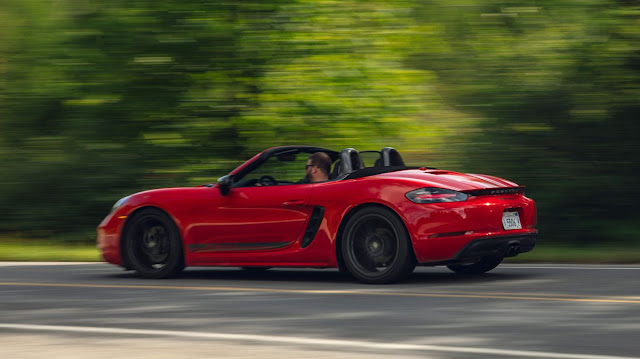2024 Range Rover Velar Remains a Fancy Confection
While at dinner one evening during the media drives for the 2024 Range Rover Velar, the server informed us the chef had prepared a special dessert: popcorn soufflé. I believe one should try things if they sound interesting, no matter what they're called. Dubious marketing occasionally hides mastery.
The server brought the dessert, its delicate white cap poking out of the traditional French soufflé dish. I tasted a spoonful of cake and the creamy pink sauce inside that bore bits of popcorn like amber in some florid tar. I wasn't prepared for the medley of flavors. It wasn't bad, and I'm glad I tried it, but I didn't have any more. It was a unique, perplexing confection, much like the Range Rover Velar.
Let's work backward with the SUV, starting with the confection. Look at the Velar, Range Rover's first public entry into what it terms "reductionism." We've called the car fetching, tailored, fine-looking, and dripping with curb appeal. It is without doubt more artfully modeled than its competitors, deftly nodding to its brand's aspirational flagship. In fact, the Velar might be better proportioned than the Range Rover it encourages its buyers to yearn for.
Tweaks for 2024
For the new year, the Velar makes many of the same changes wrought upon the 2024 Range Rover Evoque. A new grille sits between slender pixel headlights, the 268 LEDs in each headlight adjusting their illumination to shine all available light on the road, not into the eyes of oncoming drivers. In back, reshaped LED taillight signatures sit above a new rear bumper and redrawn diffuser insert that eliminates openings for the exhaust finishers.
The exterior color palette makes way for Metallic Varesine Blue and Premium Metallic Zadar Grey. Darker trim pieces provide increased contrast, and new wheel designs come in new finishes.
The 2021 Velar introduced the dished steering wheel and palm shifter the Evoque just received for 2024, so cabin changes are even more reductive. The main change is the new 11.4-inch curved touchscreen replacing the previous dual screens, and the eradication of every knob and button. On the infotainment display, three ever-present shortcut menus line the sides and the bottom, doing their part to keep 80 percent of functions within two taps of the home screen.
Leather interiors are offered in the new hues Cloud, Deep Garnet, and Raven Blue. Those who find hides distasteful can select a fabric substitute. Available only in Cloud Gray for the U.S. market, the wool blend on the seat uppers and door cards gets paired with a new ultrafiber polyurethane in more trafficked areas like seat bolsters and the steering wheel. Trim pieces come in either Shadow Gray Ash Veneer, dark anodized aluminum, or light anodized aluminum.
Serenity takes a step up with new active noise-cancellation programming. Lastly, the Cabin Air Purification Plus option integrates a carbon-dioxide sensor to deter driver fatigue. As we said of the Evoque, this is a sensational-looking cabin, sure to appeal to shoppers who ogle homes fashioned from acres of blond wood, glass, and a T-square.
Driving the 2024 Velar
Which brings us to the perplexing: The Velar is uninteresting to drive, its dynamics as reserved as its interior design. Powertrains carry over unchanged, the base Velar S and the Dynamic SE fitted standard with a turbocharged 2.0-liter four-cylinder known as the P250, making 247 horsepower and 269 pound-feet of torque. The Dynamic SE can be optioned with a turbocharged and supercharged 3.0-liter inline-six supplemented by a 48-volt mild hybrid system, known as the P400 and producing 395 horsepower and 405 pound-feet. That's the version we drove.
Both engines are paired with an excellent ZF eight-speed automatic, but in the case of the P400 V-6 the powertrain engineers were able to improve the transmission's refinement by using more of the mild-hybrid system's electric torque to fill in gaps during shifts. Around town, you'd need a millimeter wave radar to detect the swapping of cogs.
We've previously tested the P250 drivetrain (back in 2018), which took 7.2 seconds to hit 60 mph compared to Range Rover's claimed time of 7.1 seconds. With the P400, the automaker claims a 60-mph time of 5.2 seconds. Adequate if true, but still 1.4 seconds behind our tested time for the Porsche Macan S and 1.1 behind the BMW X3 M40i. The also-luxury-focused Genesis GV70 3.5T is only 0.3 second ahead of the more powerful Velar, but the Genesis is markedly more involving to drive.
The Velar's steering feel, tendency to understeer, and quietude on the go were similar to what we experienced in the Evoque, and the brake pedal feel was just as spongy. However, the Velar's ride on the standard steel springs was firmer and less pliant than the Evoque's.
Range Rover says that, against its rivals, the three pillars guiding the Velar's development were: design leadership, the greatest refinement, and the most off-road capability. It succeeds at all of them. Note that none of these are concerned with performance or visceral reactions.
Furthermore, because the Evoque and Velar use the same cabin design separated by roughly three inches of width and legroom, there's no additional drama or sense of occasion in the Velar, which costs at least $10,000 more than its compact sibling. The Velar's cargo hold, however, is much more commodious.








